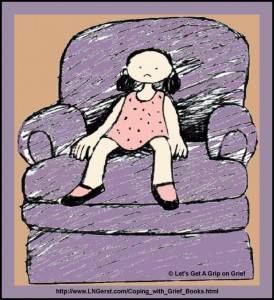 As Father’s Day is almost upon us, I want to continue with Roslyn’s train of thought from yesterday about ways to help your children mourn in a healthy manner.
As Father’s Day is almost upon us, I want to continue with Roslyn’s train of thought from yesterday about ways to help your children mourn in a healthy manner.
Before you experienced the loss of your partner, the only thing you might have known about grieving was that you were “supposed to” be strong.
And I ask: Why?
Are people supposed to be strong when they are wounded physically? I don’t think so, and crying out in pain is pretty normal behavior. There’s no difference with deep emotional pain. The normal response is weakness.
If you have children, your experience represents a great moment to teach about what types of actions illustrate weakness and strength.
The following is an excerpt from my children’s book, Let’s Get a Grip on Grief (for children under 9). I also wrote one for older children, Let’s Get a Grasp on Grief. They are both very simple books because it’s my belief that, no matter how you couch it, a child will probably never understand why his/her parent had to die.
What you can do for your children, though, is share with them what is going to come next. You can do this about the funeral; what will happen after the funeral; and address issues, such as, will they have to move, will they have to change schools, will they have to forego certain things because a lack of money, etc.
As it is with adults, uncertainty brings fear, and fear generates anger and destructiveness. A simple explanation, which gives permission for certain emotions, is a start in bringing stability to a child’s life. Furthermore, it beautifully illustrates the fact that crying or feeling sad doesn’t mean you’re weak but rather this behavior allows you to process your emotions and eventually heal.
Five Guidelines To Help Children Cope With Their Grief
A child’s healthy healing from the loss of a loved one is built upon the candid acknowledgment of the painful emotions felt, not by the denial of the tragic event.
- Allow a child to express his/her full range of grief-filled emotions. Anger, tears, fear, gloom, and protestation are all natural reactions to a new family situation.
- Allow a child to discuss a problem he/she is facing before it gets unmanageably out of control. Talk in a non-judgmental and straightforward way to encourage further disclosure and continual dialogue. Talk at the child’s level and attempt to view the situation by sitting in his/her chair.
- Encourage a child to discuss his/her deep-seated fears and emotions. Rather than talking “to” or “at” the child, listen carefully for verbal and non-verbal clues. Look for opportunities when you and a child can talk about his/her dead parent. Allow for both good and bad memories to surface and be discussed.
- Allow a child to question, doubt, and have different opinions from you. Respect the fact that each child has his/her own unique personality and that each one will deal with death differently. He/she needs the freedom (in a safe and loving environment) to search for his/her own meaning in the death of a parent or another loved one.
- If you feel unable to answer a child’s questions, please let him/her know that there are special people who are trained to do just this. Also, let him/her know that asking for help is a character strength and not a sign of weakness.
Let’s Get a Grip and Let’s Get a Grasp on Grief are available via Amazon, Barnes and Noble or my website, along with my whole collection on how to cope with grief books.

